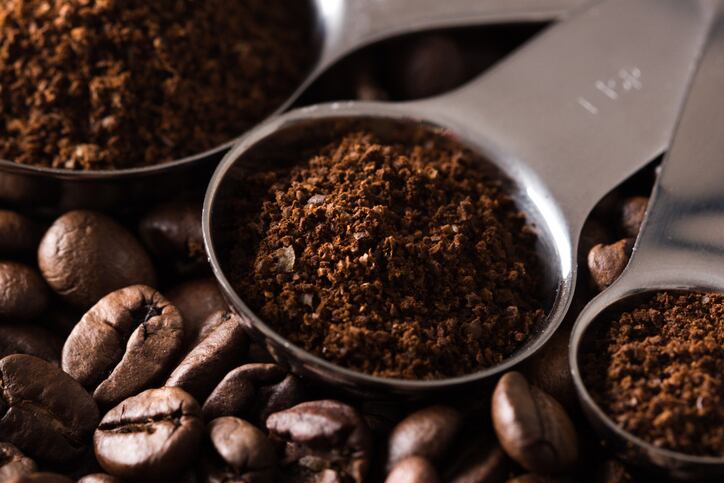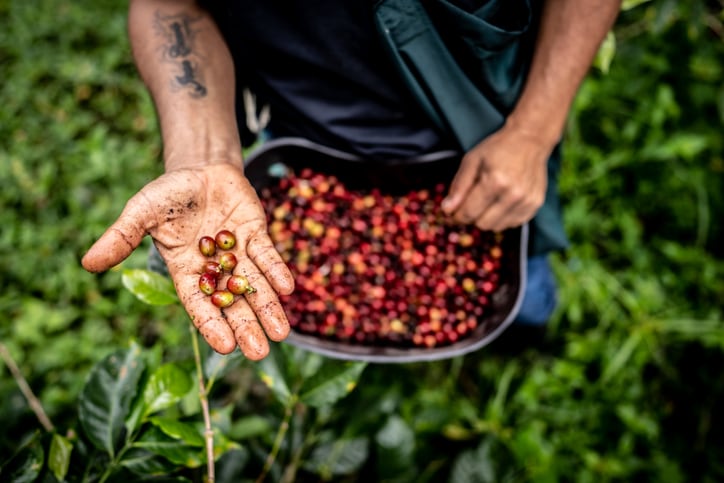Coffee is one of the most consumed beverages in the world. In the US, it’s consumed more than any other beverage.
And what’s more, our love affair with coffee is expected to last for many decades to come. So what’s worth looking out for?
Superfood coffee

At its base, coffee is already a functional food: millions of people turn to the beverage everyday for a spurt of energy. But brands are now taking that functionality and adding more benefits besides.
“While it’s true that coffee is the original ‘energy drink,’ thanks to its natural caffeine content, consumer expectations around functional beverages have expanded far beyond just energy,” said Melissa Mackay, SVP of Marketing and Insight of private label coffee manufacturer Westrock Coffee in Little Rock, Arkansas.
“The very definition of “healthy” has evolved to mean a lot more than just reducing sugar, fat or calories. Consumers are increasingly aware of functional ingredients that provide a wide range of health benefits — from improving gut health and mental clarity to immunity, preventative health, stress relief and more — and they’re looking for ways to seamless integrate these ingredients into their daily routine.”
That idea of a daily routine is why coffee is the perfect vehicle for functional benefits.
“Most US adults already drink coffee daily, so exploring new coffee products with functional ingredients is a simple way to enhance that daily habit with health benefits,” said Mackay.
Specialty coffee

Specialty coffee continues to boom.
“The amount of Americans choosing specialty coffee has increased significantly,” said William ‘Bill’ Murray, CEO and president of the US National Coffee Association. “Our latest NCDT report found that 46% of Americans had specialty coffee in the past day – an 18% increase since 2020. Last year, the number of Americans drinking specialty coffee overtook the amount drinking traditional coffee for the first time – in fact past-day specialty coffee consumption is currently at a 14-year high.
“Although it’s hard to say exactly what’s driving the growth in specialty coffee, we do know that it is most popular with those ages 25-39 with 53% of that age category having a specialty coffee in the past day. They are very closely followed by those ages 40-59 years old, with 51% of that category drinking specialty coffee in the past day.”
But what is specialty coffee, exactly? There’s no set definition, but it’s about elevating a brew to a premium experience. That could be via presentation and serve, the beans used and the story behind the coffee.
Sustainability

Consumers are thinking more and more about coffee’s journey from tropical lands to their home or coffee shop. But that’s a long way. While consumers happily champion ‘being sustainable’, honing down what that means for the coffee category is more complicated.
The issues for coffee range from sourcing (where does coffee come from? Are farmers receiving a fair wage?) to packaging (while much noise has been made of the waste created by disposable coffee cups, the reality is these still remain the default for many coffee shops and consumers).
And it’s also about considering the whole ecosystem of the coffee chain: from the farmer, to the green coffee buyer, to the roaster, and finally to the barista. Organizations like Fair Trade have spent decades championing equitable coffee, while the rise of specialty coffee has helped highlight social and environmental issues behind each bean.
Single origin coffee – a subsector of the specialty category which features coffee grown within a single geographic area with unique characteristics and tastes – is growing in popularity. That’s because it allows consumers to see where their coffee has come from (sometimes down to the level of the individual farm).
Climate change is a big concern for the coffee industry: and the species of coffee we use the most could evolve and change as a result. But that could also lead to the emergence of new varieties, tastes and flavors in coffee.
While some 70% of the world’s coffee production is Arabica, the species is very sensitive and has a low tolerance to rising temperatures and disease (around 60% of land currently used for coffee cultivation could be affected by climate change by 2050).
Plant scientists are focusing on new, higher-yielding Arabica varieties with a greater resistance to disease and drought. And they’re also looking at ‘forgotten’ wild coffee species - those that have fallen by the wayside since Arabica and Robusta became the dominant duo - but could hold the key to climate change resistance.
Coffee at home

Even before the pandemic, consumers wanted to take their favorite barista brews and recreate them at home. And 2020 drove that change faster and further.
“Home has consistently been the most popular place for Americans to enjoy their favorite brew,” said Murray of the NCA.
“The latest NCDT report found that 82% of American coffee drinkers drank their coffee at home in the past day – this figure has remained stable over time. Out-of-home coffee consumption has increased from 36% last year to 38% in this most recent report – that’s the highest consumption since before the pandemic (January 2020), and on par with pre-pandemic levels.
“The pandemic didn’t change coffee’s popularity, though of course, it did change where and how people drank their coffee. The pandemic saw at-home coffee consumption (always the most popular) hit new highs, and it increased the use of drive-through, delivery, and app-based ordering options.”
Other advancements in tech (such as at-home coffee machines) have also helped make the at-home experience even better.
Cold coffee: From indulgent treat to healthy boost

RTD coffee is everywhere: and it comes in all shapes and sizes. Iced coffee, cold coffee and nitro brews are all trending.
But those who think the category is about summer brews or novelty drinks are missing the point.
A dive into the category’s audience shows it’s the mass direction of travel for the category: Gen Z is far more likely to drink an RTD coffee than the traditional hot version. That means coffee brands need to get into the RTD game - or risk future declines.
Beverage giants have been quick to recognize the opportunities: Nestle, in particular, has ramped up innovation in the category.
As a category that’s largely about indulgence, fancy flavors are one way to draw people in. Chocolate, peanut butter, salted maple, cookies and cream are all flavors that offer classic, irresistible combos.
But RTD coffee also can tap into that health-conscious audience, says Melissa Mackay of Westrock Coffee.
“RTD is the ideal format for functional coffee beverages because it offers ultimate control over the consumer experience. We’re able to control the exact amount of any added nutrients or functional ingredients and ensure these are stable and perfectly balanced with the base flavor of the coffee. These manufacturing advantages have made canned and bottled formats the go-to choice for functional coffee beverages. With the category’s rapid growth in recent years, consumers now naturally associate RTD coffee with functionality.
“While there are certainly still many functional RTD coffees that rely on sugar and dairy to deliver a great-tasting beverage, advancements in natural sweeteners and dairy alternatives are making it easier than ever to produce BFY coffee and tea products that actually are healthier.
“Natural sweeteners based on ingredients like stevia, allulose or monk fruit all deliver a sweet profile with low- or no-calories while plant-based creamers using oat milk, coconut milk or various nut milks are providing a smooth texture without the unwanted calories or fat of traditional dairy.”

